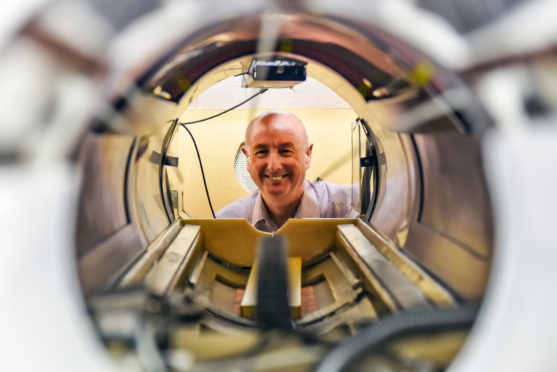The next generation of MRI scanning technology is being developed in the Granite City after a £600,000 donation from a charity founded by a family with long links to Aberdeen University.
The Mary Jamieson Hall and John F Hall Trust has donated the funds to create a “potentially life-saving” imaging suite at Aberdeen Royal Infirmary where the new Fast Field-Cycling MRI scanner will be built.
The device has been developed at the university – where the first whole-body MRI scanner was created in 1980 – and represents a major step forward in MRI technology.
It can identify disease at an earlier stage and in more detail than existing scanners and the project has been supported by a £5.6 million Euro Horizon-2020 grant.
In addition to the imaging suite, the donation will be used to fund a medical physics lectureship post: The Hall Family Lectureship in Medical Physics.
The trust was created by the Hall family which, in 1880, founded the building firm which went on to be known across Scotland as Alexander Hall & Sons Ltd.
The company became Hall & Tawse in the mid-1980s and played a significant role in shaping the face of Aberdeen and Scotland.
In addition to building Aberdeen University’s Fraser Noble and Taylor buildings, it worked on the likes of Aberdeen Royal Infirmary and Balmoral Castle.
A prototype of the FFC-MRI scanner has already been created and successfully tested on patients and healthy volunteers.
The upgraded scanner will be built inside the new facility, which will be known as the Hall Family Imaging Suite and be located within the ARI.
Professor David Lurie, biomedical imaging expert and leader of the FFC-MRI project, said: “We are really excited to be entering this next, crucial stage of the development and are extremely grateful to the Mary Jamieson Hall and John F Hall Trust for supporting the creation of this new imaging suite and funding a crucial lectureship post.
“We have been very fortunate to appoint FFC expert Dr Lionel Broche to the Lectureship. He already has excellent ideas on how to take our research forward.
“The new imaging suite will allow us to scan a much wider range of patients than before.
“Its location in the hospital will make it easy for patients to have an MRI scan immediately following their appointment, which will help us to determine what extra diagnostic information is provided by our new imaging technology and how it can be used in the future to aid diagnosis.”
The Mary Jamieson Hall and John F Hall organisation’s head trustee, Jim Birnie said the Trust’s thoughts over the past two years have been “focused on identifying the best use of its remaining funds” and, in particular, to select projects which best reflect the wishes of the Hall family.
He said: “They also made several major contributions towards medical projects focused on conditions that are common in Scotland.
“Looking back at the Hall family’s legacy, we are delighted to be able to support the development of the next phase of the development of MRI technology.
“We wish to thank all the staff at the university who have helped and guided us along the way and look forward to the completion of the Hall Family Imaging Suite during 2020.”
Professor Siladitya Bhattacharya, head of the university’s School of Medicine, Medical Sciences and Nutrition, added: “This project has the potential to diagnose disease sooner and with greater precision in a way which could potentially save many lives.”










